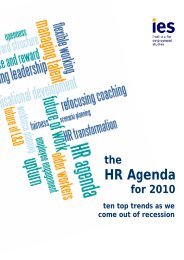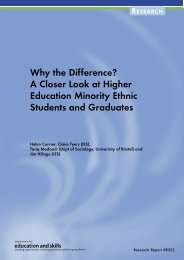Post-16 Transitions: a Longitudinal Study of Young People with ...
Post-16 Transitions: a Longitudinal Study of Young People with ...
Post-16 Transitions: a Longitudinal Study of Young People with ...
You also want an ePaper? Increase the reach of your titles
YUMPU automatically turns print PDFs into web optimized ePapers that Google loves.
Table 5.14: Occupation/training type<br />
N = %<br />
Pr<strong>of</strong>essional 5 1<br />
Associated pr<strong>of</strong>essional and<br />
12 2<br />
technical<br />
Administrative and secretarial 17 4<br />
Skilled trades <strong>16</strong>8 28<br />
Retail and customer service 97 <strong>16</strong><br />
Process, plant or machine operator 53 9<br />
Elementary occupations 230 39<br />
Other 5 1<br />
N = 588 100<br />
Note: All percentages are weighted percentages, unless otherwise stated<br />
Source: IES/MORI 2003<br />
Approximately one-quarter <strong>of</strong> young people in employment<br />
were on a Modern Apprenticeship or National Traineeship<br />
when they were surveyed, and just under one-fifth reported<br />
that they were on the New Deal or some other sort <strong>of</strong><br />
government-supported training course (Table 5.15). A small<br />
proportion (five per cent) <strong>of</strong> this group were in supported<br />
employment.<br />
Most young people who are in work, though, are not<br />
undertaking any sort <strong>of</strong> formal training programme (61 per<br />
cent). <strong>Young</strong> people who recalled having a transition planning<br />
review and a transition plan were more likely to report that<br />
they were on a Modern Apprenticeship or National<br />
Traineeship than those <strong>with</strong>out a transition plan (30 per cent<br />
compared to 20 per cent).<br />
Table 5.15: Type <strong>of</strong> training<br />
N = %<br />
Modern Apprenticeship 123 21<br />
National Traineeship 23 4<br />
Work-based training through the New Deal 25 4<br />
Other government supported training 25 4<br />
Supported employment 31 5<br />
None <strong>of</strong> the above 350 61<br />
Don't know <strong>16</strong> 3<br />
N = 588 100<br />
Note: All percentages are weighted percentages, unless otherwise stated<br />
Source: IES/MORI 2003<br />
<strong>Post</strong>-<strong>16</strong> <strong>Transitions</strong> <strong>of</strong> <strong>Young</strong> <strong>People</strong> <strong>with</strong> SEN: Wave 2 73

















